
Pietro Lorenzetti or Pietro Laurati was an Italian painter, active between c. 1306 and 1345. Together with his younger brother Ambrogio, he introduced naturalism into Sienese art. In their artistry and experiments with three-dimensional and spatial arrangements, the brothers foreshadowed the art of the Renaissance.

Benedetto Bonfigli was an Italian Renaissance painter born in Perugia, and part of the Umbria school of painters including Raphael and Perugino. He is also known as Buonfiglio. Influenced by the style of Domenico Veneziano, Benozzo Gozzoli, and Fra Angelico, Bonfigli primarily painted frescos for the church and was at one point employed in the Vatican. His best-preserved work is the Annunciation, but his masterpiece is the decoration of the chapel of the Palazzo dei Priori. Bonfigli specialized in gonfaloni, a Perugian style using banners painted on canvas or linen. Little is known of his personal life, but he was an esteemed painter in Perugia before Perugino, who is said to be his pupil.

Filippo Lippi, also known as Lippo Lippi, was an Italian painter of the Quattrocento and a Carmelite priest. He was an early Renaissance master of a painting workshop, who taught many painters. Sandro Botticelli and Francesco di Pesello were among his most distinguished pupils. His son, Filippino Lippi, also studied under him and assisted in some late works.

The Deposition, also known as the Pala Baglioni, Borghese Entombment or The Entombment, is an oil painting by the Italian High Renaissance painter Raphael. Signed and dated "Raphael. Urbinas. MDVII", the painting is in the Galleria Borghese in Rome. It is the central panel of a larger altarpiece commissioned by Atalanta Baglioni of Perugia in honor of her slain son, Grifonetto Baglioni. Like many works, it shares elements of the common subjects of the Deposition of Christ, the Lamentation of Christ, and the Entombment of Christ. The painting is on wood panel and measures 184 x 176 cm.
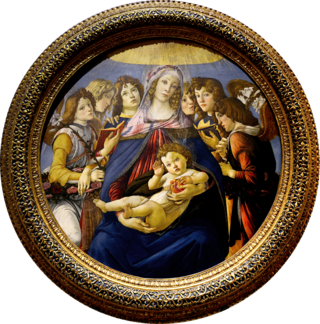
The Madonna of the Pomegranate was painted in circa 1487 with tempera on a wood panel by Sandro Botticelli. It is now in the Uffizi in Florence. Sandro Botticelli was a leading Italian Renaissance artist from Florence, Italy. The Madonna (art) uses the circular format, better known as a tondo, which focuses the attention on the main characters, the Virgin Mary and baby Jesus, who are surrounded symmetrically by angels on each side. Botticelli's use of tempera grassa give the characters a real look, better known as a "naturalistic" style, which is common during the Renaissance. The Virgin Mary is holding baby Jesus gently in her arms while holding a pomegranate in her left hand.

Florentine painting or the Florentine School refers to artists in, from, or influenced by the naturalistic style developed in Florence in the 14th century, largely through the efforts of Giotto di Bondone, and in the 15th century the leading school of Western painting. Some of the best known painters of the earlier Florentine School are Fra Angelico, Botticelli, Filippo Lippi, the Ghirlandaio family, Masolino, and Masaccio.

Neri di Bicci (1419–1491) was an Italian painter active in his native Florence. A prolific painter of mainly religious themes, he studied under his father, Bicci di Lorenzo, who had in turn studied under his father, Lorenzo di Bicci. The three thus formed a lineage of great painters that began with Neri's grandfather.
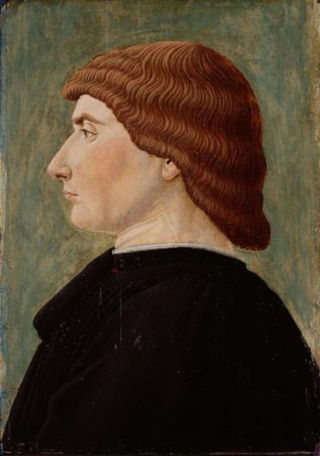
Fra Carnevale OP was an Italian painter of the Quattrocento, active mainly in Urbino. Widely regarded as one of the most enigmatic artists, there are only nine works that can be definitively attributed to Carnevale known of today. Most of these have even been contested as authentic to Carnevale at various points in history.
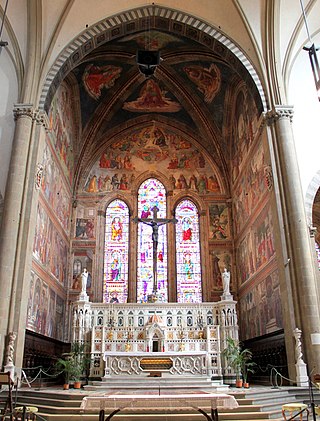
The Tornabuoni Chapel is the main chapel in the church of Santa Maria Novella, Florence, Italy. It is famous for the extensive and well-preserved fresco cycle on its walls, one of the most complete in the city, which was created by Domenico Ghirlandaio and his workshop between 1485 and 1490.
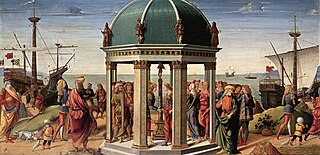
Biagio d’Antonio Tucci was an Italian Renaissance painter active in Florence, Faenza and Rome.
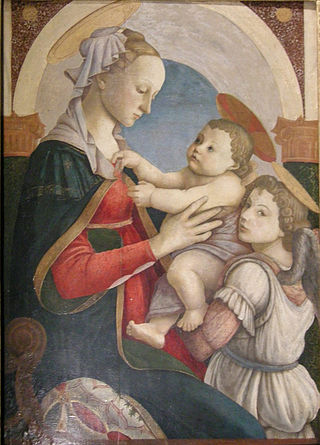
The Madonna and Child with an Angel is a painting by the Italian Renaissance painter Sandro Botticelli, c. 1465–1467. It is housed in Spedale degli Innocenti of Florence.

The Coronation of the Virgin is a painting of the Coronation of the Virgin by the Italian Renaissance master Filippo Lippi, in the Uffizi, Florence.

The Barbadori Altarpiece is a painting by Filippo Lippi, dated to 1438 and housed in the Louvre Museum of Paris.

The Apparition of Christ to the Virgin is a painting by the Italian Renaissance master Filippino Lippi, executed around 1493 and now housed in the Alte Pinakothek of Munich, Germany.

The Annunciation has been one of the most frequent subjects of Christian art. Depictions of the Annunciation go back to early Christianity, with the Priscilla catacomb in Rome including the oldest known fresco of the Annunciation, dating to the 4th century.

Madonna with Child is a painting by the Italian Renaissance artist Filippo Lippi. The date in which it was executed is unknown, but most art historians agree that it was painted during the last part of Lippi's career, between 1450 and 1465. It is one of the few works by Lippi which was not executed with the help of his workshop and was an influential model for later depictions of the Madonna and Child, including those by Sandro Botticelli. The painting is housed in the Uffizi Gallery, Florence, Italy, and is therefore commonly called “The Uffizi Madonna” among art historians.
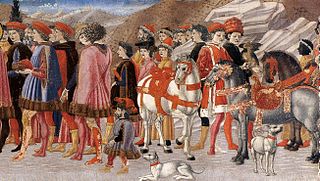
Giovanni di Francesco del Cervelliera or Giovanni di Francesco was an Italian Renaissance painter, active in Florence in the mid-fifteenth century.

The Pisa Altarpiece was a large multi-paneled altarpiece produced by Masaccio for the chapel of Saint Julian in the church of Santa Maria del Carmine in Pisa. The chapel was owned by the notary Giuliano di Colino, who commissioned the work on February 19, 1426 for the sum of 80 florins. Payment for the work was recorded on December 26 of that year. The altarpiece was dismantled and dispersed to various collections and museums in the 18th century, but an attempted reconstruction was made possible due to a detailed description of the work by Vasari in 1568.

The Novitiate Altarpiece or Madonna and Child with Saints is a c.1440-1445 tempera on panel painting by Filippo Lippi, now in the Uffizi in Florence. A sacra conversazione, it originally had a predella painted by Pesellino centred on a Nativity. The main panel shows Cosmas and Damian either side of the Madonna and Child, whilst Francis of Assisi is shown at far left and Anthony of Padua at far right. On an architectural frieze above the figures are the Medici's heraldic balls.

The Mystical Nativity or Adoration in the Forest was painted by Fra Filippo Lippi around 1459 as the altarpiece for the Magi Chapel in the new Palazzo Medici in Florence. It is now in the Gemäldegalerie, Berlin, with a copy by another artist now hanging in the chapel. It is a highly individual depiction of the familiar scene of the Nativity of Jesus in art, placed in a mountainous forest setting, with debris from woodcutting all around, rather than the familiar stable in Bethlehem, and with the usual figures and animals around the mother and child replaced by others.



















